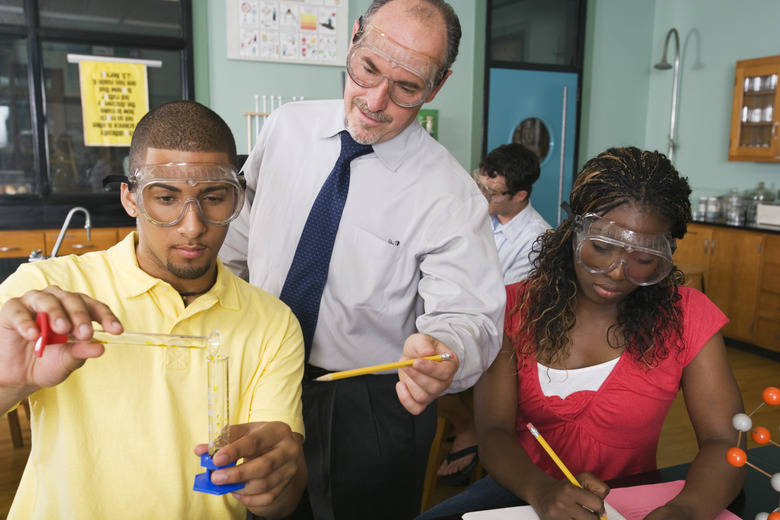Classroom Activities On The Scientific Method
The term "scientific method" perhaps summons to mind serious-looking people in white coats in lab rooms, surrounded by beakers, whirring machines and sophisticated computers. But the scientific method has nothing to do with equipment or technology and everything to do with a process for gathering and refining data, information and knowledge.
The scientific method, then, is a philosophy, a blueprint and an ethic. Think of the difference between an effort to learn about something and a commitment to a method of learning. The former might involve surfing websites in a haphazard way and deciding that the ones boasting material that confirm your own pre-existing biases are also the most informative, making it easy to "conclude," for example, that the Earth is flat and that the moon landings in the second half of the 20th century never occurred. The latter, however, means sorting objectively through data and facts no matter the direction in which these lead.
The Scientific Method, Explained
The Scientific Method, Explained
Perhaps ironically or perhaps fittingly, different scientific sources offer slightly different takes on what the scientific method specifically entails. In general, the basic steps are:
- Make observations.
- Think of a research question.
- Formulate a hypothesis.
- Design and perform an experiment.
- Analyze data in light of your hypothesis.
- Form one or more conclusions.
It's important for you to understand that you don't have to be in science class or even be considering hard science topics to use the scientific method. If you happen to look out a classroom window and see a group of people staring at the sky shielding their eyes, and are unable to join them directly, you are making an observation that lends itself to the scientific method. What might they be looking at? A low-flying airplane could be one answer. Alien invaders might be another. A particularly beautiful moon is yet another. From there, your mind can sift through the various possibilities and evaluate their likelihood. If your hypothesis was that the moon was the object of scrutiny, you'd have to produce research questions that would help you determine whether this is possible, such as "Has the moon risen today?" and "What phase is the moon in?"
Scientific Method Worksheet
Scientific Method Worksheet
The scientific method is fundamentally the same no matter who uses it, be they middle school or elementary school students, or NASA scientists. When you want to add to the body of human knowledge, include these steps:
**Clearly identify the question you are trying to solve.** For example, "Why is attendance at professional soccer games down (or up) in my area?" Don't use open-ended questions such as, "Is soccer popular?"
**Decide how to investigate the matter.** Will you use the Internet? Questionnaires? Both?
**Form a hypothesis.** Critically, your hypothesis must be subject to verification or refutation. "Aliens built the pyramids in Egypt and then disappeared without a trace" is not falsifiable or verifiable, so it is not a scientific hypothesis, just an assertion.
**Design and perform an experiment.** It's vital to keep in mind that this "experiment" might mean simply looking at existing data in a new way; it doesn't have to mean setting up a formal experiment. For example, you might survey your classmates about their eating and sleeping habits and attempt to link coffee consumption with hours of sleep per night.
**Analyze your data.** You'll want to find a way to visually present your findings so that others can easily understand what they mean, such as with tables or charts.
**Draw conclusions.** Here, review your hypothesis and decide as objectively as possible whether your experiment supports, refutes or fails to adequately address your hypothesis. Often, good experiments only invite more questions, so don't be discouraged if this happens to you.
Scientific Method Activity
Scientific Method Activity
Basic scientific investigation activities can increase students' confidence in their ability to not only learn new information about the world, but also to become more skilled and thorough thinkers. One example of a student scientific method activity is the bubble-gum lab in the Resources. The trick is bearing in mind that science can be about anything that exists, not just "biology," "physics," "climate" or any of the fields students hear so much about.
Cite This Article
MLA
Beck, Kevin. "Classroom Activities On The Scientific Method" sciencing.com, https://www.sciencing.com/classroom-activities-on-the-scientific-method-12749340/. 22 October 2018.
APA
Beck, Kevin. (2018, October 22). Classroom Activities On The Scientific Method. sciencing.com. Retrieved from https://www.sciencing.com/classroom-activities-on-the-scientific-method-12749340/
Chicago
Beck, Kevin. Classroom Activities On The Scientific Method last modified August 30, 2022. https://www.sciencing.com/classroom-activities-on-the-scientific-method-12749340/
